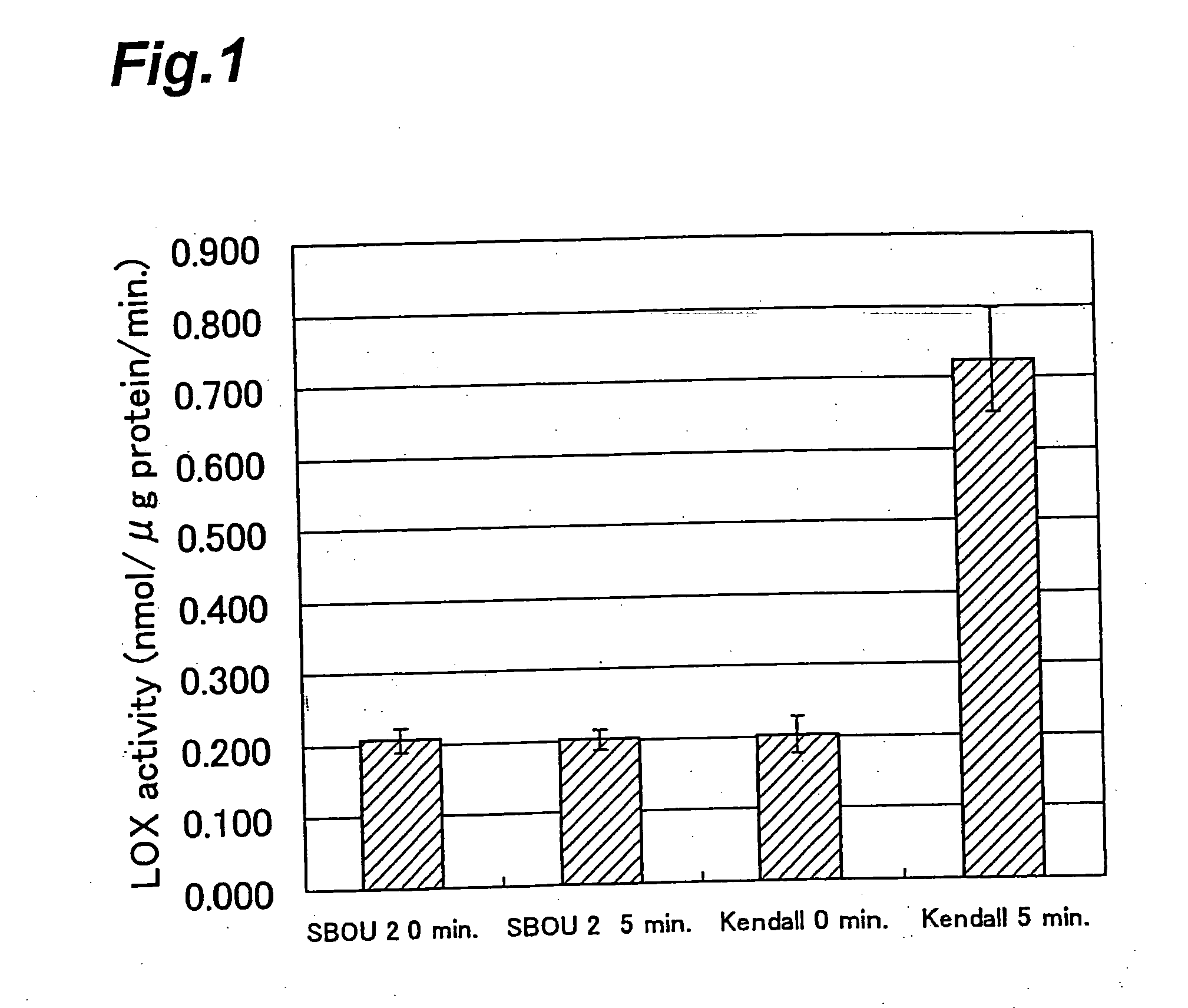Barley Lipoxygenase 1 Gene, Method of Selecting Barley Variety, Material of Malt Alcoholic Drinks and Process For Producing Malt Alcoholic Drink
a lipoxygenase and barley technology, applied in the field of barley lipoxygenase1, can solve the problems of reducing the stability of beer foam, affecting the smoothness of beer flavor, and imparting astringent flavor, so as to improve flavor stability and foam stability.
- Summary
- Abstract
- Description
- Claims
- Application Information
AI Technical Summary
Benefits of technology
Problems solved by technology
Method used
Image
Examples
examples
[0095]The present invention will now be explained in greater detail through the following examples, with the understanding that these examples are in no way limitative on the invention.
[0096]Search Test 1 (Search for LOX-1 Deficient Barley by LOX-1 Enzyme Activity Measurement)
[0097]LOX-1 enzyme activity was measured by the method described below, and a search for LOX-1 deficient barley was conducted from barley gene resources.
[0098]First, a crude enzyme solution was extracted from barley seeds by the following method. One mature barley seed was crushed with a hammer, and 500 μL of extraction buffer (0.1 M sodium acetate buffer (pH 5.5)) was used for extraction with shaking at 4° C. for 30 minutes. The obtained extract was centrifuged for 10 minutes at 15,000 rpm, and then the supernatant was taken as a crude enzyme solution.
[0099]Next, 5 μL of substrate solution (40 mM linoleic acid, 1.0% (W / V) Tween20 aqueous solution) and 85 μL of extraction buffer were added to 10 μL of the crude...
example 1
AfaI Polymorphism Examination of Other Barley Varieties
[0135]General barley varieties / lines were used for AfaI polymorphism examination. A total of 32 varieties / lines were used: Mikamo Golden, Golden Melon, Haruna Nijo, Myogi Nijo, Sakitama Nijo, Wasedori Nijo, Agurimochi, Harupin Nijo, Ryofu, Hokuiku 33, Hokuiku 35, Prior, Schooner, Sloop, Lofty Nijo, Franklin, Betzes, Harrington, Manley, B1251, CDC Kendall, CDC Stratus, CDC Copeland, Hanna, Merit, AC Metcalfe, TR145, Chariot, Stirling, Proctor, Koral and Heartland. As a result of AfaI method polymorphism examination, it was determined that the tested varieties were not the SBOU2 type, but instead were digested at the restriction enzyme AfaI site containing the splicing donor site of the 5th intron (nucleotides 60-63 of SEQ ID NO: 1: 5′-GTAC-3′) (FIG. 11). This indicated that these viable lines did not possess a DNA mutation at the AfaI site (nucleotides 60-63 of SEQ ID NO: 1: 5′-GTAC-3′), and therefore that the AfaI method can be ...
example 2
Gene Resource Search
[0136]Worldwide gene resources of barley (landrace) stocked at Okayama University were examined by the AfaI method. As a result, five new lines (SBOU1, SBOU3, SBOU4, SBOU5 and SBOU6 stocked at Okayama University) were discovered which were not digested at the restriction enzyme AfaI site containing the splicing donor site of the 5th intron (nucleotides 60-63 of SEQ ID NO: 1: 5′-GTAC-3′) (FIG. 12).
[0137]The LOX-1 activity of seeds of these lines was measured by the method described in Search Test 1. The activity measurement for SBOU5 and SBOU6 was carried out by reaction for 5 minutes (FIG. 13A), while activity measurement for SBOU1, SBOU3 and SBOU4 was with an extended reaction time of 90 minutes for clear identification of activity (FIG. 13B). As a result, no significant activity was found in any of the lines (FIG. 13).
[0138]This clearly demonstrated that SBOU2 as well as SBOU1, SBOU3, SBOU4, SBOU5 and SBOU6 (SBOU2 type LOX-1 deficient barley) were LOX-1 deficie...
PUM
| Property | Measurement | Unit |
|---|---|---|
| temperature | aaaaa | aaaaa |
| temperature | aaaaa | aaaaa |
| storing temperature | aaaaa | aaaaa |
Abstract
Description
Claims
Application Information
 Login to View More
Login to View More - R&D
- Intellectual Property
- Life Sciences
- Materials
- Tech Scout
- Unparalleled Data Quality
- Higher Quality Content
- 60% Fewer Hallucinations
Browse by: Latest US Patents, China's latest patents, Technical Efficacy Thesaurus, Application Domain, Technology Topic, Popular Technical Reports.
© 2025 PatSnap. All rights reserved.Legal|Privacy policy|Modern Slavery Act Transparency Statement|Sitemap|About US| Contact US: help@patsnap.com



